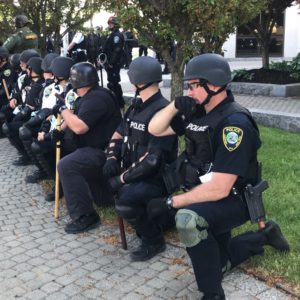Across the country, the TV news has shown footage of police kneeling, hugging and marching with demonstrators against police violence.
Unfortunately, police often behave far differently once the cameras are off.
I saw this firsthand when I was arrested for peacefully protesting in downtown Los Angeles. On June 2, soon after Mayor Eric Garcetti took a knee with protesters outside City Hall, I was held at gunpoint, arrested and subjected to abuse by the Los Angeles Police Department.
Outside Garcetti’s house about 4:30 p.m., I watched the media swarm around a cop and a handful of black folks marching down the street and hugging in solidarity. At the time, curfew was 6 p.m., and a police officer informed protesters that since we had stayed peaceful, we could have the “privilege” of staying past curfew.
The police and the media exited the premises, and we continued to protest.
At 8 p.m., we began peacefully marching around the mayor’s neighborhood. Twenty minutes later, police abruptly stopped us at gunpoint. We immediately dropped to our knees and put our hands up in surrender.
There were about 100 protesters, and the cops outnumbered us by about double. For the next 45 minutes, guns were pointed at our heads while we helplessly knelt on the pavement chanting “peaceful protest.”
While I was scared that I was going to die, the cops in front of me laughed.
At 9 p.m., the cops began arrests. One by one, they zip tied our hands behind our backs and lined us up, separated by gender along the street. They joked about the identity of one protester, Julia Dupuis — “Do you think it’s a female? Are you sure?”
We were loaded into cages on a bus. I asked the cops where we were headed. They replied, “We don’t know.” The bus stopped at various places around the city, including a cemetery. They never informed us of our final destination.
We spent four hours caged and received no water, food or access to a restroom. The zip ties were so tight around our hands that many of us began losing circulation. One woman begged the cops to loosen her zip tie due to a chronic shoulder injury, but they ignored her.
Another woman, crying due to an unbearable loss of blood circulation, broke her zip tie with a lighter. A handful of other women losing circulation joined her.
Another one of my bus mates was an essential worker, uninvolved with the protests. On her drive home from work, the cops pointed guns at her, forced her to exit her vehicle, and arrested her. She repeatedly tried to show them her essential worker badge and pleaded to retrieve her inhaler from her car, but they ignored her. For the entire bus ride, she struggled to breathe.
After about three hours, we arrived at a police station that ordinarily should have been just 20 minutes away. A cop entered the bus to begin our release — until he noticed that some of the women had removed their zip ties. He said that our release was delayed until we were “good girls.”
While the cops prolonged our suffering until we “learned a lesson,” one of my bus mates peered out of a slit in the bus and saw cops snapchatting and watching TV.
We were released at 1:20 a.m. We received citations, and we were left without transportation home or access to a phone (most of our cell phones were dead).
As a white woman, my experience by no means compares to the level of brutality the police have imposed on black people every single day. Adesie Butler, who was arrested with me, reflected that “this night brings attention to what we as black people are going through daily. I want everyone to learn from it.”
No mainstream media covered the abuse we experienced that night, but the mayor taking a knee went viral.
Police may show solidarity when the media is present, but that can evaporate when they’re not. “The cop in me wants to kick my own (butt),” an NYPD sergeant later wrote to his colleagues, days after he’d been recorded kneeling with demonstrators.
The lesson is clear: Take any story you see about police officers showing unity with protesters with a grain of salt.

